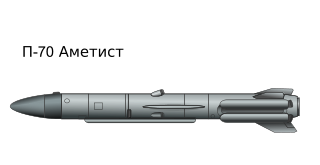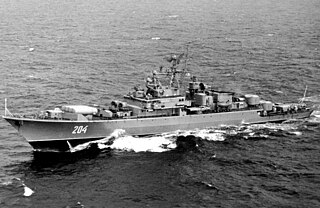
K-222 was the first and only Project 661 nuclear-powered cruise-missile submarine built for the Soviet Navy during the Cold War. Although the Soviets saw K-222 as an unsuccessful design, upon completion it was the world's fastest submarine and the first to be built with a titanium hull.

K-77 was a "Project 651" diesel–electric submarine built for the Soviet Navy during the 1960s. Commissioned in 1965, the boat was armed with long-range cruise missiles to carry out its mission of destroying American aircraft carriers and bases. The missiles could be fitted with either conventional or nuclear warheads.

A ballistic missile submarine is a submarine capable of deploying submarine-launched ballistic missiles (SLBMs) with nuclear warheads. These submarines became a major weapon system in the Cold War because of their nuclear deterrence capability. They can fire missiles thousands of kilometers from their targets, and acoustic quieting makes them difficult to detect, thus making them a survivable deterrent in the event of a first strike and a key element of the mutual assured destruction policy of nuclear deterrence.

A cruise missile submarine is a submarine that carries and launches cruise missiles as its primary armament. Missiles greatly enhance a vessel's ability to attack surface combatants and strike land targets, and although torpedoes are a more stealthy option, missiles give a much longer stand-off range, as well as the ability to engage multiple targets on different headings at the same time. Many cruise missile submarines retain the capability to deploy nuclear warheads on their missiles, but they are considered distinct from ballistic missile submarines due to the substantial differences between the two weapons systems' characteristics.
K-131 was a Project 675 of the Soviet Navy's Northern Fleet, she was also redesignated K-192.

A submarine-launched cruise missile (SLCM) is a cruise missile that is launched from a submarine. Current versions are typically standoff weapons known as land-attack cruise missiles (LACMs), which are used to attack predetermined land targets with conventional or nuclear payloads. Anti-ship cruise missiles (ASCMs) are also used, and some submarine-launched cruise missiles have variants for both functions.

The Echo class were nuclear cruise missile submarines of the Soviet Navy built during the 1960s. Their Soviet designation was Project 659 for the first five vessels, and Project 675 for the following twenty-nine. Their NATO reporting names were Echo I and Echo II. All were decommissioned by 1994.

Whiskey-class submarines are a class of diesel-electric attack submarines that the Soviet Union built in the early Cold War period.
K-56 was a Project 675 nuclear submarine of the Soviet Navy.

S-80 was a diesel-electric submarine of the Soviet Navy.
The P-500 Bazalt is a turbojet-powered, supersonic cruise missile used by the Soviet and Russian navies. Its GRAU designation is 4K80 and its NATO reporting name is SS-N-12 Sandbox, its upgraded version being the P-1000 Vulkan AShM SLCM.

The P-5 "Pyatyorka", also known by the NATO codename SS-N-3C Shaddock, is a Cold War era turbojet-powered cruise missile of the Soviet Union, designed by the Chelomey design bureau. The missile entered service in 1959. Pyatyorka is a common name for the missile as the "digit 5", corresponding to the R-7 Semyorka, the digit 7.

The P-70 Ametist was an anti-ship missile carried by Soviet and Indian Project 670 submarines, as well as the Soviet Project 661 Anchar. It was soon succeeded by the P-120 Malakhit (SS-N-9 'Siren').

The Project 670 Skat submarine was a nuclear-powered cruise missile submarine built for the Soviet Navy and later operated by the Russian Navy. All Charlie I/II-class submarines are decommissioned. One Charlie-class submarine was used for testing an Oniks missile. Charlie I and its successor Charlie II-class submarines are designed by the Lazurit Central Design Bureau of Gorky.
The S-99 experimental submarine was the only ship of the Project 617 class that the Soviet Union built during the early Cold War. She was the only Soviet submarine which used a German Walter turbine fueled by high-test peroxide (HTP). Entering service in 1956, the boat was assigned to a training unit of the Baltic Fleet. S-99 was badly damaged by a HTP explosion in 1959 and was not repaired. The submarine was decommissioned in 1964 and subsequently scrapped.

Bodryy was a Project 135 Burevestnik-class Large Anti-Submarine Ship or Krivak-class frigate. Launched on 15 April 1971, the vessel served with the Soviet Navy until it was dissolved and then was transferred to the Russian Navy. The ship played a key role in helping the Soviets develop techniques for tracking ballistic missile submarines in the 1970s. Bodryy was retired on 17 July 1997 and scrapped.

Vitse-Admiral Drozd was the third ship of the Project 1134 Berkut Large Anti-submarine Ships built for the Soviet Navy, also known as the Kresta I-class or Admiral Zozulya-class guided missile cruisers. The vessel was launched on 18 November 1966 and served with the Baltic Fleet through the 1970s and 1980s. As well as taking part in naval exercises in the Atlantic, the ship assisted in the rescue of the crew of the stricken submarine K-19 in March 1972. Subsequently, the ship was visited by Sergey Gorshkov, commander of the Soviet Navy. The vessel was reclassified a Large Rocket Ship in 1977 to reflect its multi-purpose capability. After an upgrade in 1981, Vitse-Admiral Drozd continued to operate in the Mediterranean Sea and Atlantic Ocean until being decommissioned on 1 July 1990. The ship was sent to India to be scrapped in March 1992 but sank en route.

K-70 was a "Project 651" diesel–electric submarine built for the Soviet Navy during the 1960s. Commissioned in 1965, the boat was armed with long-range cruise missiles to carry out its mission of destroying American aircraft carriers and bases. The missiles could be fitted with either conventional or nuclear warheads. K-70 was initially assigned to the Northern Fleet, but was transferred to the Pacific Fleet a few months later. The submarine was decommissioned in 1989 and subsequently scrapped.

K-68 was a "Project 651" diesel–electric submarine built for the Soviet Navy during the 1960s. Commissioned in 1965, the boat was armed with long-range cruise missiles to carry out its mission of destroying American aircraft carriers and bases. The missiles could be fitted with either conventional or nuclear warheads. While much of the submarine's activities during the Cold War are unknown, she did make at least one patrol in the Mediterranean Sea before serving as the test bed for an auxiliary nuclear reactor from 1976 to 1991. K-68 was decommissioned in 1992 and subsequently scrapped.

K-85 was a "Project 651" diesel-electric submarine built for the Soviet Navy during the 1960s. Commissioned in 1965, the boat was armed with long-range cruise missiles to carry out its mission of destroying American aircraft carriers and bases. The missiles could be fitted with either conventional or nuclear warheads. While much of the submarine's activities during the Cold War are unknown, she did make at least two patrols in the Mediterranean Sea while assigned to the Northern Fleet. The submarine was renamed B-124 in 1977 and was transferred to the Baltic Fleet four years later. B-124 was decommissioned in 1993 and subsequently scrapped.
















